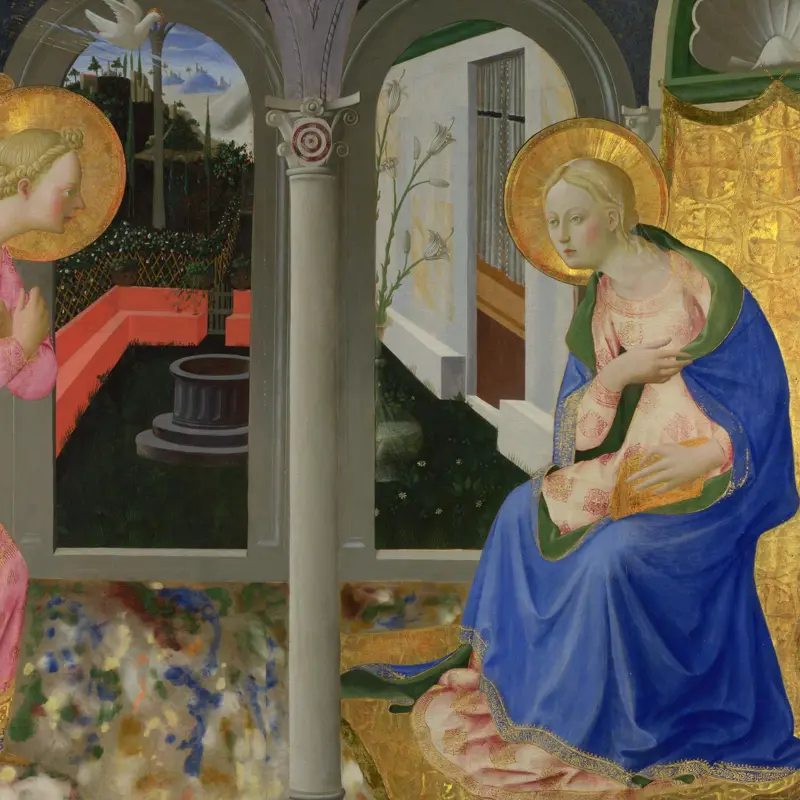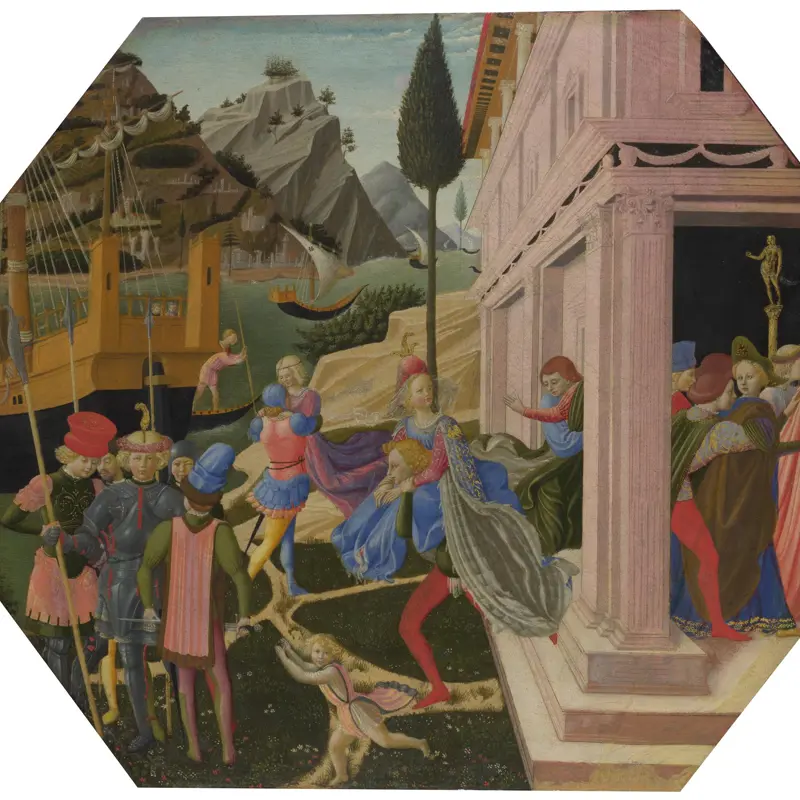Probably by Zanobi Strozzi, 'The Adoration of the Kings', about 1433-4
About the work
Overview
Three men have followed a star – you can see it just inside the stable – to pay homage to the infant Christ. These wise men, sometimes called kings – here they all have crowns – are shown kneeling before him. One has set his crown aside and kisses the newborn’s foot, showing reverence to him.
This panel has been associated with the Florentine painter Zanobi Strozzi, who was also a skilled manuscript illuminator. Illuminations were often highly decorative with plenty of gold leaf and minute attention to detail. The meadow that the kings and their attendants kneel in is filled with a variety of tiny flowers and grasses; some look like daisies. Their costumes are embellished with gold patterns.
We don’t know which altarpiece this predella (the lowest part of an altarpiece) panel belonged to, but it has been connected with a panel showing the Nativity of Christ in the Metropolitan Museum of Art, New York.
Key facts
Details
- Full title
- The Adoration of the Kings
- Artist
- Probably by Zanobi Strozzi
- Artist dates
- 1412 - 1468
- Date made
- about 1433-4
- Medium and support
- egg tempera on wood
- Dimensions
- 19 × 47.4 cm
- Acquisition credit
- Bought, 1857
- Inventory number
- NG582
- Location
- Room 57
- Collection
- Main Collection
Provenance
Additional information
Text extracted from the ‘Provenance’ section of the catalogue entry in Dillian Gordon, ‘National Gallery Catalogues: The Fifteenth Century Italian Paintings’, vol. 1, London 2003; for further information, see the full catalogue entry.
Exhibition history
-
2013Florence!Kunst-und Ausstellungshalle der Bundesrepublik Deutschland22 November 2013 - 9 March 2014
Bibliography
-
1903J.A. Crowe and G.B. Cavalcaselle, A History of Painting in Italy, Umbria, Florence and Siena, from the Second to the Sixteenth Century, ed. R.L. Douglas, 2nd edn, 6 vols, London 1903
-
1923R. van Marle, The Development of the Italian Schools of Painting, 19 vols, The Hague 1923
-
1950L. Collobi Ragghianti, 'Zanobi Strozzi pittore, 2', Critica d'arte, XXXIII, 1950, pp. 17-27
-
1951Davies, Martin, National Gallery Catalogues: The Earlier Italian Schools, London 1951
-
1961M. Davies, The Earlier Italian Schools, 2nd edn, London 1961
-
1963B. Berenson, Italian Pictures of the Renaissance: A List of the Principal Artists and Their Work, with an Index of Places: Florentine School, 2 vols, New York 1963
-
1983M. Levey, The Neglected National Gallery: An Exhibition of Paintings from the Lower Floor (exh. cat. The National Gallery, 20 April - 31 May 1983), London 1983
-
1986Davies, Martin, National Gallery Catalogues: The Earlier Italian Schools, revised edn, London 1986
-
2001
C. Baker and T. Henry, The National Gallery: Complete Illustrated Catalogue, London 2001
-
2003Gordon, Dillian, National Gallery Catalogues: The Fifteenth Century Italian Paintings, 1, London 2003
About this record
If you know more about this work or have spotted an error, please contact us. Please note that exhibition histories are listed from 2009 onwards. Bibliographies may not be complete; more comprehensive information is available in the National Gallery Library.


